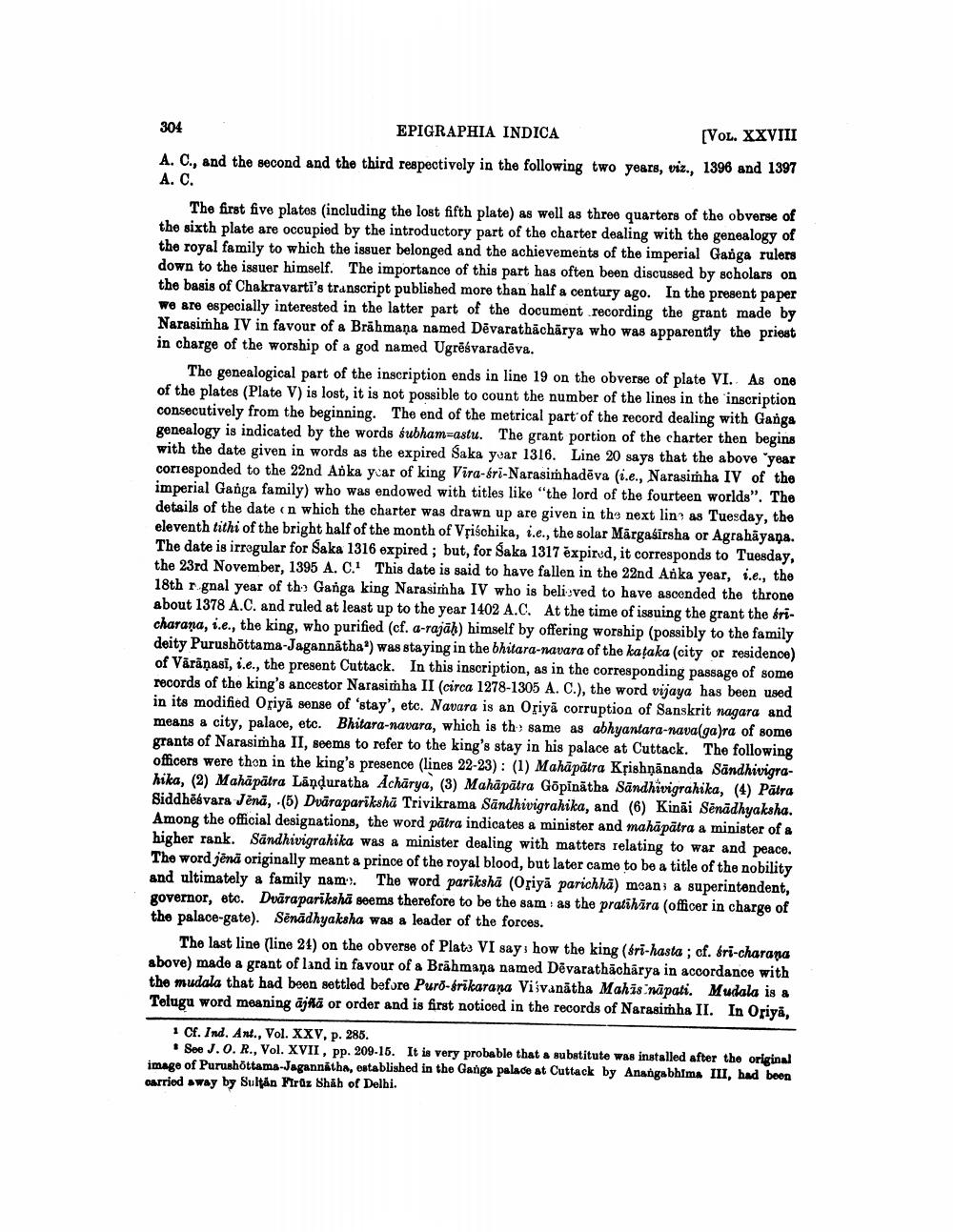________________
304
EPIGRAPHIA INDICA
[VOL. XXVIII A. C., and the second and the third respectively in the following two years, viz., 1396 and 1397 A. C.
The first five plates (including the lost fifth plate) as well as three quarters of the obverse of the sixth plate are occupied by the introductory part of the charter dealing with the genealogy of the royal family to which the issuer belonged and the achievements of the imperial Ganga rulers down to the issuer himself. The importance of this part has often been discussed by scholars on the basis of Chakravarti's transcript published more than half a century ago. In the present paper We are especially interested in the latter part of the document recording the grant made by Narasimha IV in favour of a Brāhmaṇa named Dēvarathācharya who was apparently the priest in charge of the worship of a god named Ugrēsvaradēva.
The genealogical part of the inscription ends in line 19 on the obverse of plate VI. As one of the plates (Plate V) is lost, it is not possible to count the number of the lines in the inscription consecutively from the beginning. The end of the metrical part of the record dealing with Ganga genealogy is indicated by the words subham-astu. The grant portion of the charter then begins with the date given in words as the expired Saka year 1316. Line 20 says that the above "year corresponded to the 22nd Anka year of king Vira-bri-Narasimhadēva (i.e., Narasimha IV of the imperial Ganga family) who was endowed with titles like "the lord of the fourteen worlds". The details of the date on which the charter was drawn up are given in the next linas Tuesday, the eleventh tithi of the bright half of the month of Vpiśchika, i.e., the solar Märgaśīrsha or Agrahāyana. The date is irregular for Saka 1316 expired; but, for Saka 1317 expired, it corresponds to Tuesday, the 23rd November, 1395 A. C. This date is said to have fallen in the 22nd Anka year, i.e., the 18th r gnal year of the Ganga king Narasimha IV who is believed to have asoended the throne about 1378 A.C. and ruled at least up to the year 1402 A.C. At the time of issuing the grant the tricharana, i.e., the king, who purified (cf. a-rajāb) himself by offering worship (possibly to the family deity Purushottama-Jagannathaa) was staying in the bhitara-navara of the kataka (city or residence) of Varanasi, i.e., the present Cuttack. In this inscription, as in the corresponding passage of some records of the king's ancestor Narasimha II (circa 1278-1305 A. C.), the word vijaya has been used in its modified Oriyā sense of 'stay', etc. Navara is an Oriya corruption of Sanskrit nagara and means a city, palace, etc. Bhitara-navara, which is the same as abhyantara-nava(ga)ra of some grants of Narasimha II, seems to refer to the king's stay in his palace at Cuttack. The following officers were then in the king's presence (lines 22-23): (1) Mahāpātra Krishņānanda Sandhivigrahika, (2) Mahapätra Länduratha Acharya, (3) Mahapätra Göpinātha Sandhivigrahika, (4) Pätra Siddhēsvara Jena, .(5) Dvaraparikshā Trivikrama Sandhivigrahika, and (6) Kināi Senādhyaksha. Among the official designations, the word pātra indicates a minister and mahāpātra a minister of a higher rank. Sāndhivigrahika was a minister dealing with matters relating to war and peace. The word jena originally meant & prince of the royal blood, but later came to be a title of the nobility and ultimately a family nam. The word pariksha (Oriya parichha) moan & superintendent, governor, etc. Dvarapariksha seems therefore to be the sam: as the pratihāra (officer in charge of the palace-gate). Senādhyaksha was a leader of the forces.
The last line (line 24) on the obverse of Plata VI say, how the king (Sri-hasta ; cf. fri-charana above) made a grant of land in favour of a Brahmaņa named Devarathacharya in accordance with the mudala that had been settled before Puro-srikarana Visvanatha Mahis nāpati. Mudala is a Telugu word meaning ajAlä or order and is first noticed in the records of Narasimha II. In Oriya,
1 Cf. Ind. Ant., Vol. XXV, p. 285.
• See J.O. R., Vol. XVII, pp. 209-15. It is very probable that a substitute was installed after the original image of Purushottama Jagannatha, established in the Ganga palace at Cuttack by Anangabhima III, had been carried away by Sultan Hroz Shah of Delhi.




